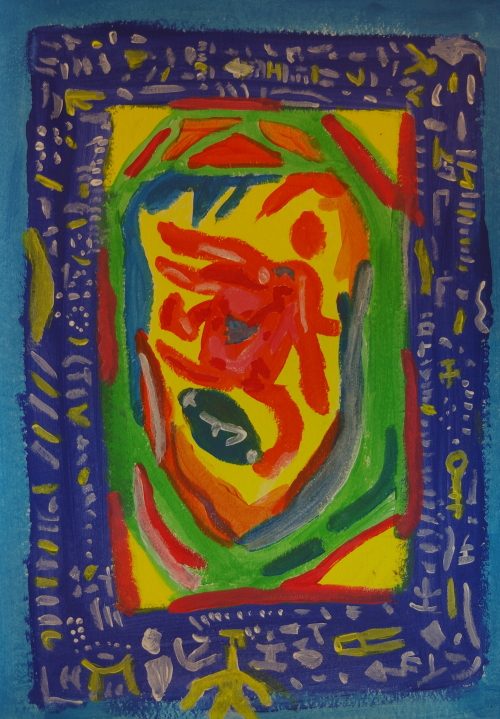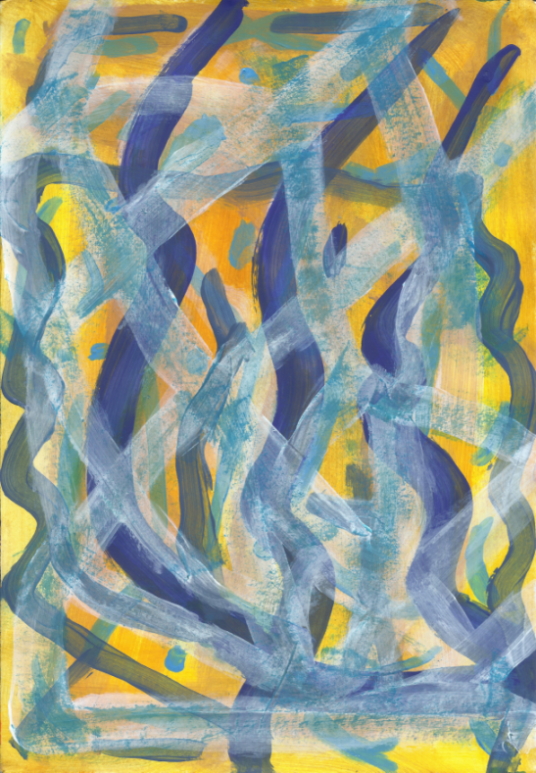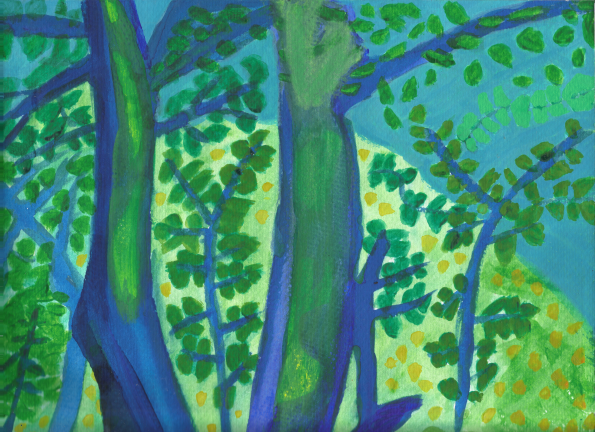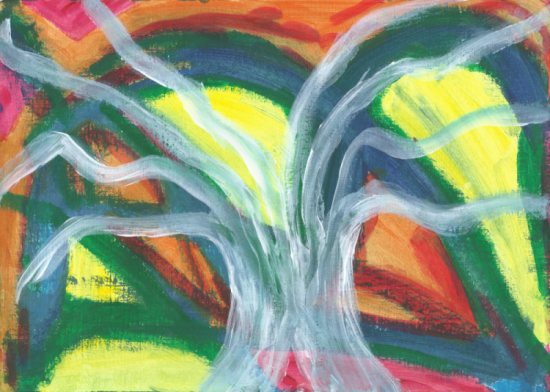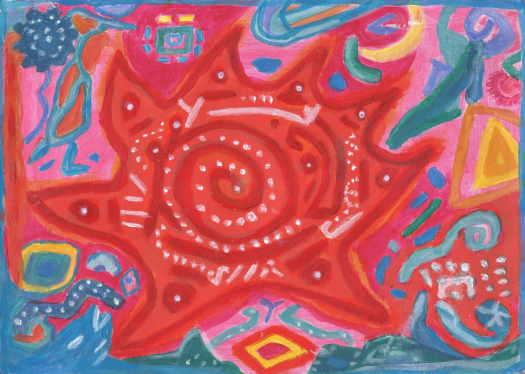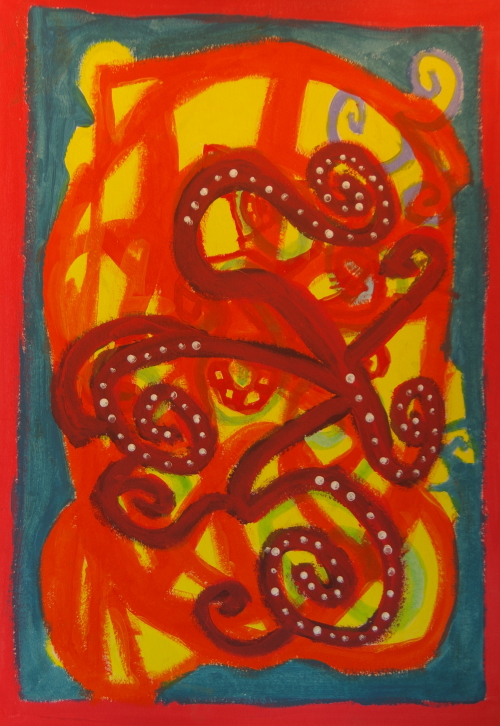
Personal Blogs

Handpainted original for sale in my shop at Etsy:
https://www.etsy.com/uk/listing/1348351837/heartwood
Thankyou. May you be well peaceful and happy.
MIndfulness of dhamma categories
This is the fourth foundation of mindfulness. There are five categories here to be mindful of: the five hindrances; the five aggregates of clinging; the six external and six internal sense bases; the seven factors of awakening; and the four noble truths.
What follows is my current understanding of the fourth foundation of mindfulness:
The five hindrances
These are: greed, aversion, stagnation, restlessness, and doubt.
They are called hindrances, because they are what stop us from reaching the deep states of meditation and prevent us from seeing things clearly, they distort our perception of reality.
Greed/lust is like being in debt, one feels a sense of lack and does not feel happy until one gets what one wants, this longing, this wishing is unpleasant and creates a feeling of disatisfaction and dis -ease in the mind. Like when coloured dye is added to water, the water looks attractive but it distorts things and makes them unclear.
Aversion is like being afflicted by a sickness. Anger/hatred is painful, it literally poisons the body with harmful toxins, like a burning coal that one picks up and throws, which burns oneself as well as where it is thrown. It is like boiling water that distorts the surface so one cannot see clearly.
Stagnation is like being in prison. One feels stuck and unable to escape the dullness and drowsiness, the fatigue. Like a stagnant pond with slime and algae growing over the surface, one cannot see the water clearly.
Restlessness is like being a slave to a control freak of a boss, who never leaves you alone, is always making demands on your time and pushing you. It is like the wind blowing ripples and waves across the surface of water making it difficult to see it clearly.
Doubt is like being at a crossroads and not knowing which way to go. If the wrong choice is made it could be disastrous. One cannot stay choosing for long as that is also dangerous because their are bandits about. So one has to make a choice and hope they pick the right direction. Doubt is like muddy water, where one cannot see clearly into the depths.
Mindfulness is being trained to notice a hindrance when it is present in the mind, note what caused it to arise, learn what makes it tick, and how to remove it from the mind and prevent it from arising again in the future. The instructions on how to deal with the five hindrances are in right effort, the sixth factor of the noble eightfold path. Mindfulness is to carry out the instructions of right effort and become the sentinel of consciousness.
One way to observe the hindrances is through watching one's thoughts. Interrupting them if they manifest any of the hindrances, then replacing them with thoughts which are the opposite.This is hard work, but eventually with persistence and determined effort, the mind when freed from the hindrances will be full of happy peaceful thoughts. It then becomes easier to settle into meditation and the thoughts will naturally calm and grow quiet. Continually bringing one's attention back to the meditation object is also a way to seclude the mind from the hindrances.
The five aggregates of clinging
These are the five streams that come together to make up a living being: The body, feelings, perceptions, mental volitions, and consciousness.
They are called the five khandas in Pali, and the five skandhas in Sanskrit.
They are streams because they are always changing with nothing lasting or substantial behind them. Just like one never sees the same stream twice. A stream can give the illusion of looking the same as it flows past, but the water molecules one is observing are different each moment.
The five aggregates are just processes rising, flowing, fading outside of our control. The body ages, changes, gets sick and dies whether we like or not. Feelings come from sense impressions which happen because of the environment around us. Perceptions change.Thoughts and emotions change. Consciousness just reflects all this, constantly changing from moment to moment. Non of it is the self. Not me, not mine.The five aggregates arise because of causes and conditions. When one looks closely with a mind that is serene and lucid, one cannot find a substantial self in any of them, it is all just process flowing and changing from one moment to the next.
It can be helpful to become aware of how we cling to these streams and identify with them. And how this clinging causes us suffering.
This lack of substance applies to other beings as well. Our connections with others are also insubstantial. Everyone is changing. When we get attached to and cling to other beings, this causes us suffering, because when the inevitable happens and we eventually become separated from them it can cause us great emotional pain and distress when they are no longer around; or when they change and are no longer the same person they were.
Every being we meet leaves an impression on the mind. Their voices and energies make their home there in some fashion. Our heads becoming a mix of all the different beings we meet. The traces they leave on us shaping who we are, and who we become.
The mind is always needing to cling to something. I think because of the uncertainty impermanence creates. Meditation is a form of clinging. It creates a state of mind that does not last, but it is a useful illusion of stability, one that secludes one from the five hindrances to help one see things clearly and decrease one's suffering.
This huge web of interdependence, a complex weave of cause and effect, constantly changing, with nothing substantial behind any of it.
Who am I? Who are you? What is the self?
The six external and six internal sense bases
These are the six senses, both the contact and the impression that contact makes on the mind. The six senses are: sight, sound, smell, taste, touch, and the mind sense (called the mind sense because it is able to look at itself and get a snapshot of one's mood, emotions, one's state of mind).
The Buddha gives a simile of six animals all pulling in diferent directions at the same time on ropes that are tied to a common knot in the centre. The six animals represent the six senses, the ropes tied together is a metaphor of how they are all connected together and pull the mind in different directions.
There is a meditation one can practise here, where one can place one's awareness in the body and use that feeling of embodiment as an anchor. To stake and peg the communal knot to the ground.
The six animals continue tugging on the ropes but are no longer pulling you off in different directions. You keep grounded in the body and remain still and calm, allowing those sensations and feelings to just be without creating a story out of them anymore.
Eventually the six senses start to settle down and stop pulling. They go quiet and things get very still and pleasant. This can bring a feeling of liberation and a reduction to suffering.
With much practise it starts to feel like a super power, especially in this modern world. The ability to become still and content while the world goes on around one, no longer feeling the need to get involved with it. Not always easy to do, it takes patience and perseverance, and playing the long game, but in time it can become a supernormal power that brings with it a freedom from clinging to the world of the senses.
The seven factors of awakening
These are the support beams that hold up the awakened mind. One is to cultivate and develop these till they become second nature. One becomes mindful of their presence in the mind, and how to keep them going continuously in a constant cycle. Which is the second set of instructions in Right effort.
The seven factors of enlightenment are: mindfulness, wonder, energy, joy, serenity, samhadi, and equanimity.
Mindfulness is the first factor of awakening, and also stays present throughout the whole cycle. The whole process of awakening starts with remembering, being mindful.
Wonder is the second factor of awakening. Often translated as investigation of dhamma, or investigation of phenomena, but I find these translations remind me too much of the dryness of school,which doesn't really enthuse me all that much. I prefer wonder because the word brings back to me the feeling of being a child and looking at the sky and the clouds, the wonder of life, of earth, the water, the feeling of air on my skin, seeing its invisible presence as it moves through the plants and trees, the wonder of fire, of light and colour, and the warm energy of the sun. The wonder that there is even such a thing as sky, water, earth, air, life, the sun, and stars in the night sky. Wonder brings interest which gathers the mind together into a state of absorption and brings into being the next factor of awakening...
Energy. When one is interested in something one feels energised and enthused. It is the opposite of boredom which creates dullness and a lack of energy. Energy in this factor is also the momentum built up by repeated effort, and the drive and motivation to succeed at something. Energy is closely linked to the next factor of awakening...
Joy. Energy and joy go together. Which is where the word enjoyment comes from. Joy is an important component of the enlightened mind, if one skips this step, it can lead to drowsiness and one may fall asleep before they reach the later factors. For many this is one of the hardest factors to bring into being. But if done right, wonder, interest and energy should naturally bring some joy to the mind. And one starts to enjoy oneself.
Serenity is the fifth factor of awakening. The excitement and rapturous energy of joy naturally starts to calm and grow quiet, leading to a feeling of tranquility and calm. This is a very pleasant feeling, like relaxing on the porch at the end of an exciting day, it can feel satisfying to chill out when the excitment of joy has settled down. Which takes one to the doorstep of the next factor of awakening...
Samhadi. Samhadi is a difficult word to translate from Pali. It is a combination of meditation, composure, centredness, collectedness, wholeheartedness, flow, stillness, unification of mind, serenity and lucidity. It is also an emotional experience of beautiful states of mind, an experience of the deep, of the divine, of the higher states of consciousness. In the Buddha's teachings there are four stages to samhadi, called the four jhanas, which are covered in the eighth factor of the noble eightfold path so I won't go into them here. A rough translation of the word jhana is meditation. The four jhanas (meditations) naturally lead to the seventh factor of awakening...
Equanimity. This is where all the energies of the mind that pull us this way and that are perfectly tuned and in balance, in sync and pacified. It is where mindfulness becomes purified by a state of perfect equipose. It is from this state of mind that one can see things clearly and penetrate the truth of them without the distortion caused by disunity of mind.
Then the whole cycle of the seven factors of enlightenment begins again. As one gets better at cultivating this, one starts to develop the wisdom faculty. Where one wonders about and investigates the three characteristics of phenomena which are: change/impermanence (both in the short term and long term), that there is no substantial self, and how clinging to this changing phenomena brings us suffering. Which gradually leads to the insight and the wisdom that changes one permanently and begins the irreversible process of awakening.
The four noble truths
1. Knowledge of suffering. (Which is to be understood.)
Understanding how the mind is always wanting to cling to something. And how clinging to things that change, is suffering.
2. Knowledge of the cause of suffering. (Which is to be abandoned.)
Understanding that the cause of suffering is greed, hatred, and delusion. Which correspond to the three kinds of craving: craving for things we think will make us happy (grasping); craving for something unpleasant to be otherwise (pushing away); and craving for becoming, for continued existence, the delusional story of self.
The three are tangled up with one other, and feed off one another, creating a momentum that strengthens and reinforces one another. Greed and hatred both spring from delusion (also known as ignorance). One weakens greed and aversion first, which then makes it easier to get to the root of the problem, delusion.
By abandoning greed, hatred, and delusion we abandon the cause of suffering in the mind. As craving is the cause of clinging. When we become less ignorant of this, and remind ourselves of it over and over again, using the three characteristics as a tool to help one develop dispassion and disenchantment towards the changing things of the world, one begins to start naturally letting go.
Which leads to the third noble truth.
3. Knowledge of the end of suffering. (Which is to be realised.)
As one lets go of the clinging to the world, one starts to experience greater and greater states of liberation, till eventually there is no more clinging at all, and no more suffering. Just a mind perpetually at ease, at peace, cycling through the seven factors of awakening, not clinging to anything in the world.
Realisation of this truth is a complete and permanent end to suffering. And one experiences nibbana, which is the mind freed from greed, hate, and delusion. The goal of the path. A mind no longer shaken, disturbed or unsettled by the changing nature of phenomena. A mind that does not suffer anymore.
4. Knowledge of the way that leads to the end of suffering. (Which is to be developed.)
However in the meantime you need to cling to something to get to nibbana: the raft that gets you across the river: the noble eightfold path. This is what trains and conditions the mind to become an instrument capable of penetrating and understanding the four noble truths and fully letting go and realising the third noble truth.
The eightfold path both works together as a cohesive whole, each factor supporting the others. As well as cycling through each factor in a linear fashion over and over. The wisdom, understanding and development of the mind growing deeper and more profound with each cycle till it is fully liberated.
But until the mind is fully liberated one clings to the path and doesn't let go till the end. The raft is a bundle of sticks one holds onto while in the water. The sticks symbolise the teachings contained in the eightfold path. The paddling that gets you across the river is right effort. If one lets go of the raft before one reaches the other shore, then one will be carried and swept away by the current of greed, hate, and delusion.
It is only when one reaches the other shore, that one can put down the raft. Then one can let go of the path and chill out on the shores of nibbana knowing that what needed to be done is done, that there is nothing further to do, freed permanently from clinging and suffering. .
How long this takes varies from person to person, their inclination and motivation, and how much dust is in their eyes. It might take lifetimes, years, months, weeks, days, a night, a dhamma talk, or the time it takes to shave one’s head. The current world record holder for full enlightenment is recorded in the suttas about a twelve year old boy who became fully enlightened in the time it took to shave his head (-:
And of course like the Buddha, out of compassion, one can then choose to share the teachings with others and guide them to the end of suffering, but only if they ask and want to know, Buddhism is not a proselytising religion.
If one would like to learn more about right mindfulness I recommend this series of talks by Ajahn Sona recorded during a virtual mindfulness retreat that took place during the pandemic:
https://youtube.com/playlist?list=PLCXN1GlAupG0D2tTYFGurLptbA4pTB4k6
With Metta.
May you find peace of mind and freedom from suffering.
Mindfulness of the mind (citta-anupassanä)
The third foundation of right mindfulness is about being aware of our state of mind, our mood, emotions, attitude.
It is a wonder that the human mind is able to look at itself and know its state at all. That it is able to both observe itself and act at the same time. In Buddhism there are six senses: sight, sound, smell, taste, touch, and mind. The sixth sense is called the mind sense because it is able to look at itself. The mind can be detached from the five senses of the body, but it cannot be detached from itself.
Consciousness happens in distinct and discrete moments, but happens so fast that it gives the impression those separate moments are happening at the same time. And perhaps what is happening when the mind is watching itself, is there is a discrete moment of consciousness, followed closely by another where the mind is noting that moment of consciousness, like the mind playing a game of tennis with itself.
These mind moments are always changing, and the feeling of there being a permanent observer watching the mind is just an illusion, the observer is not really there, it is just a transitory conscious moment in a sequence of discrete causal events. A stream of conscious moments with no substantial self behind it. Not me, not mine, not self.
Thankfully the Buddha keeps the task of watching the mind simple and advises us to keep track of just eight states of mind and their opposites. He teaches us to note whether the mind is:
- greedy or not,
- hateful or not,
- deluded or not,
- collected or scattered,
- developed or undeveloped,
- surpassable (easily overcome) or unsurpassable (invincible),
- in lucid stillness (samhadi) or not,
- liberated or not.
The Buddha purposely says greedy or not, hateful or not, deluded or not, because there are many wholesome emotional states that are not greedy, hateful, or deluded. So one can replace the word 'not' with any of those.
The Buddha advises one to note the manifestation, arising and passing away of these states of mind, as well as to contemplate these states of mind internally and externally. I think when he says internally and externally he means to contemplate and understand the state of mind of other beings as well as one's own.
However one should remember that just mere awareness and noting states of mind is not all there is to this practise. Noting can be helpful in the beginning to help one become aware of these states of mind and get skilled at spotting them quickly. But ultimately one is training to remove these negative states of mind altogether and bring into being wholesome ones to replace them, such as the seven factors of enlightenment which is covered in the fourth foundation of mindfulness.
Much of our suffering comes from these negative states of mind. In fact the cause of suffering is greed, hatred, and delusion. And the end of suffering, nibbana is when these three poisons have been permanently removed from the mind. When the mind is no longer harrassed by greed, hate, and delusion it is luminous and shines like the moon that comes out from behind the clouds.
To free the mind is no small task though. It is challenging, as these tendencies of the mind are strong, and they will resist your efforts to remove them, so one has to do this gradually and pace oneself. Avoid straining the mind by exerting too much effort, as this is counterproductive and will lead to more harm, more suffering. This path is not a quick fix, it takes time and patience, and perseverence. So be gentle with yourself, be compassionate and kind. There has to be some effort, else nothing will change, but too much effort will cause burnout and psychological distress. So one needs to tune the effort so it doesn't strain the mind nor make one lazy and unmotivated. Those negative states will keep coming back over and over, and often one's progress and development comes from making mistakes, from one's failures. So don't be hard on oneself for not being perfect and not knowing everything, just keep persevering and being patient. Learn from mistakes and try try try again. As one makes progress and gets more developed, one gets faster at removing and replacing these negative states, until it becomes like second nature, and then a new habit structure of the mind is formed and then one becomes unsurpassable.
The Buddha said that anger is a great stain on the personality but fairly easy to get rid of. Greed is a lesser stain on the personality and hard to get rid of. Delusion is both a great stain on the personality and very hard to get rid of.
Anger is painful, so it is easier to motivate oneself to get rid of anger, it is always accompanied by an unpleasant feeling. Anger can arise from sights, sounds, smells, tastes, touch, and ideas in the world around one. And the world can try to make one angry on purpose. It will say you should be angry about this, angry about that, why aren't you angry? If you are not then there must be something wrong with you. Everyone else is angry about it, you should be too. There can be pressure sometimes socially to be angry. But one does not have to follow the rest of the world. You do not have to reflect the world or other people's anger. The Buddhist path is all about how you feel, are you suffering or not? To feel anger and hatred is suffering. There's enough anger and hatred, enough suffering in the world, why add to it. One is actually doing a service to the world when in the midst of all the craziness, anger, and hatred, one remains serene, at ease, and filled with loving-kindness and compassion.
Greed is hard to remove and is also a bit trickier to spot as it is a mix of pain and pleasure. Greed here is a general term that also covers lust and craving for intoxicants.There is pain in wanting something and not getting it, but there is also gratification when one does get what one wants, even though that gratification is transient, it is still not easy to motivate the mind to get rid of greed. Again the world will be advertising, pushing the buttons of craving, telling you that you need this or that, that your life is not complete without something it is trying to sell you. But again one does not have to be greedy, does not have to want these things, can find contentment without them. Even if the rest of society thinks you are strange for not wanting those things. One has to look at the drawbacks of greed, how hard one has to work for worldly-pleasures, how expensive they are, how the material things you accumulate can be taken away from you by others, how they are impermanent, can break and don't last, how they do not lead to lasting happiness, how it all leads to misery in the end, all that is beloved and pleasing to us will become otherwise, one is fated to become separated from all one loves and holds dear. If one is serious about ending suffering, one has to decide: do you want money, sex, and intoxicants? Or do you want enlightenment?
Delusion is the root of both anger and greed. And delusion comes from ignorance. In Buddhism it is knowledge of the four noble truths and the deep understanding of them which brings wisdom and deliverance from ignorance.
Samhadi or lucid stillness, is a state of mind where greed, hatred, and delusion is temporarily suspended, it is not permanent and the negative mind states will return, but in samhadi one gets a taste of what the mind is like when it is not being harrassed by these psychic irritants. Right samhadi is a composed state of mind, serene, wholehearted, lucid and still. A mind collected and unified, the connection to big mind and divine consciousness, and the next factor of the noble eightfold path. Right mindfulness takes you to the doorstep of right samhadi and also stays throughout the experience of it.
I will stop here as I am feeling a bit tired and think perhaps I have written enough for a brief summary of what I am learning. Mindfulness of the mind should always be practised in the context of the noble eightfold path and not separate from it. All factors of the path must be practised together to reach the destination. If any of the factors are left out, the vehicle to nibanna won't work.
May you feel safe, well, happy, and peaceful.
Mindfulness of feelings
The second foundation in the four foundations of mindfulness is about sense impressions and the mental feeling of pleasure or displeasure that accompanies them. Sense impressions generate feelings, and feelings generate craving.
There are two ways to look at feelings. The first is to look at there being just two kinds of feelings: pleasant or unpleasant. The second way is to look at there being three kinds of feelings: pleasant, neutral, or unpleasant. The Buddha said both ways of looking at feelings is correct. And he also said there is in fact a total of 108 feelings, but one doesn't need to know about them to get liberated, and working with just a set of two or three is enough.
An important thing to grasp here is that a neutral feeling after a painful feeling feels pleasant; and a neutral feeling after a pleasant feeling feels unpleasant. Which makes one wonder if there really is a neutral feeling? Imagine there's a scale with pleasure at the top and pain at the bottom. Feelings get more pleasurable as they go up the scale and more unpleasant as they go down it. So when a hit of pleasure wears off, if the feeling that comes after that is below it in the scale it will feel unpleasant, even if it is a feeling one would normally class as pleasant. This also works vice versa, when one is in pain, any feeling above that in the scale will feel pleasant in comparison, even if it is something that would normally be called unpleasant.
One notices feelings that come from the five senses: eye, ear, smell, taste, touch. As well as feelings that come from the sixth sense: the mind, which is the psychological world of thoughts and ideas. Noting which ones are pleasant and which ones are unpleasant, or which ones are neither pleasant nor unpleasant (neutral).
One also notices what are called worldly feelings.The eight worldly winds can be a helpful tool to simplify this.The eight worldly winds are: pain and pleasure, gain and loss, success and failure, praise and blame. They can blow in either direction and can change at any moment, so one cannot experience one wind without also experiencing it's opposite. For example, perhaps one day you are being praised by a friend for something you did, this feels very pleasant and you feel encouraged and happy. Then a week later you might do something daft and are then belng blamed by that same friend, which feels unpleasant and you feel discouraged and dejected. Blame is particularly unpleasant when it comes after an experience of praise, and vice versa, praise feels very pleasant after an experience of blame. There may also be dry neutral moments when the winds are quiet and you are not getting much praise or blame, but those neutral moments will feel pleasant if they come after being blamed and unpleasant and disatisfying after praise.
There are also pleasant and unpleasant unworldly (spiritual) feelings. The pleasant feelings are the fruits of the path, such as the relief from letting go of the attachment to worldly things, the pleasure of samhadi (deep states of meditation), friendship. Unpleasant spirtual feelings are those that come from still having to live with an unliberated mind still afflicted by the three poisons of: greed, hatred and delusion. This pain can be used in a positive way to spur one forward in the practise of developing the higher mind. There is also the unpleasant feelings that happen when one's meditation practise feels dry.
One notices feelings as they arise, flow and fade away. Noting if they are pleasant, unpleasant or neutral. And one notes whether they come from the five senses, the mind sense, or if they are worldly, or unworldly feelings.
Feelings change a lot and so do our moods in response to them. But they are not actually who you are, there is no substantial self behind feelings. It is just streams of sensory data and your mental response to it of like or dislike, which creates craving for more pleasant feelings and aversion towards the unpleasant ones. But feelings are 'not me, not mine.' They arise because of the six senses: sight, sound, smell, taste, touch, mind and the world of ideas.
The Buddha coined a great simile called 'the second arrow.' Where he talks about a man who has been shot with an arrow, and immediately takes out his bow and shoots himself with a second arrow. This simile is about how there are things that happen in life which are painful and unpleasant, and outside our control. This on its own is bad enough, but then we go and create more pain and misery for ourselves by getting angry and depressed about it. 'Why me? Why does the universe hate me so? I hate my life... and so on' We've all done it! But this part is optional. Something that helped me understand this, is seeing that anger and hate never feels good, anger is always accompanied by an unpleasant feeling, which is why a neutral feeling after anger feels pleasant. Anger is unpleasant and causes suffering. When you see this you realise that anger is unnecessary and doesn't solve anything, it just makes things worse, just adds more suffering. If one is not angry it reduces suffering hugely. It is a life-changing revelation to see that one does not have to be angry about anything, one can choose non-anger instead and feel better and more serene in spite of it all.
There is something interesting to note here. When one is watching feelings arise and pass away. You can be detached from sights, sounds, smells, tastes, and touch, but the mind cannot be detached from anger. Anger and non-anger are mutually exclusive, only one or the other can exist in the mind at any time. For example, joy cannot be present in the mind if there is anger, loving-kindness cannot be present if there is anger, serenity cannot be present if there is anger. It is either one or the other. This is an important thing to remember, and something that is often misunderstood.
Another thing that is often misunderstood is that one should be detached from pleasant spiritual feelings when they arise. This is incorrect, pleasant spiritual feelings come from the fruits of the path and are the rewards of the spiritual life and are to be cultivated and enjoyed, even when one becomes a fully enlightened being. The Buddha would often ask not to be disturbed, so he could sit in his hut and enjoy the bliss of meditation. He also said that the only time he didn't have backache was when he was practising samhadi.
Mindfulness of feelings is a huge topic and I haven't covered everything. There's more to feelings, such as how feelings of love can act as pain-relief, there's even been scientific research to explore this effect of love on the mind.
There's also other beings feelings to consider. Knowing that other beings also dislike pain and enjoy pleasure just as much as you do, this can help with the development of empathy and compassion. How feelings all have one thing in common in that they are impermanent and change. How this impermanence causes craving and suffering. How it leads to addictions and dissatisfaction when the senses start to become jaded. For example when you listen to a piece of good music over and over, and after a time you start feeling bored of it and long to have that sensory hit again, but can't get the same effect from it, so one searches for another song to fill the void. How a good book or movie can feel very pleasurable, but when you get to the end there's a sadness that it is over and a feeling of dissatisfaction. These are all things to explore in the practise of mindfulness of feelings. But I will stop here as I am trying really hard to make this succinct.
In the next part of right mindfulness, I will write about the next foundation: mindfulness of the mind, which covers moods, emotions, state of mind. But I am tired now and going to bed. Nighty night. Peace and love everyone (-:
To be continued...
May everyone feel safe, well, happy, and serene (-:
The word mindfulness means to keep something in mind. To remember.
In Buddhism there are four foundations to Right mindfulness, these are:
1. The body,
2. Feelings (In Buddhism feelings are a mix of sense impressions and the mental tone of like/dislike that accompanies them, they are not emotions, emotions come under the third foundation of mindfulness.)
3. Mind (emotions, mood, state of mind).
4. Dhamma categories (the teachings on how to use mindfulness to reach nibbana and the end of suffering.)
This is not something that one goes over in one go like a piece of music, this is more a collection of meditation objects, some reflective/contemplative, others for entering states of lucid stillness (samhadi). One does not have to do everything on this list every time they meditate, one just simply chooses a topic that fits well for the situation or mood one is in. A bit like a swiss army knife of helpful tools for different occasions.
Mindfulness of the body
This starts with awareness of the four postures: walking, standing, sitting or lying down. When one is sitting, one knows they are sitting, when standing, one knows they are standing... and so on... This helps train us to become more aware of the body.The feeling of embodiment can be a pleasurable experience, as it can feel grounding and stops the head floating off like a helium balloon.
Next is mindfulness of breathing. This is something many of us will already be familiar with, so I won't write much, other than one important thing to note is that mindfulness of the breath is not meant to be a dry experience. One should develop interest in it, a sense of wonder about the air element, as this makes the meditation more enjoyable and easier to practise. In time it becomes an indulgence, an opportunity to have a break from your worldly concerns, a tonic that you can take with you anywhere, and the freedom to disengage from the thought processes for a time.
Next is mindfulness of the present moment. This is about being aware of where one is, one's surroundings, what one is doing, one's behaviour, of that which is appropriate, and that which is non-delusion. A lucid awakeness during the course of daily life. Here one maintains a sense of composure and dignity, whilst respecting the space and peace of others as you go about your day.
Next is a list of 32 parts of the body, listed by the Buddha as: head hair, body hair, skin, nails, teeth, flesh, sinews, bones, bone marrow, kidneys, heart, liver, spleen, diaphragm, lungs, intestines, mesentery, contents of stomach, faeces, bile, pus, blood, sweat, fat, tears, grease, spittle, mucus, oil of joints, fat, and urine.
This exercise is mainly for monks and nuns to help them deal with lust. But it can be helpful for lay people too, as our world is caught up in attachment to the body, which generates much misery and leads to desire, obsession, body dysphoria, mental illness, and the stress of trying to live up to social expectations on how the body should look and perform.To be free of all that worry is a real blessing.
The first five parts in the Buddha's list are easy to remember, and these are also the body parts we tend to find attractive in ourselves and others: head hair, body hair, skin, nails and teeth. It is interesting to note that these are also the dead parts of the body.The living parts, which are hidden under the layer of skin, we find repulsive and are slightly afraid of. It is odd really. What is attraction?
The most beautiful hair in the world becomes otherwise if it lands in one's soup. A pile of discarded nails is not particularly appealing, nor a set of teeth in a glass.The skin is actually a dead leaky covering, not alive at all, and not even particularly nutritious it seems, as maggots when they eat a corpse, they don't eat the skin. They look for wounds, and openings so they can eat the flesh inside. Once all the flesh is eaten, the skin just flops over bones like a discarded leathery covering.
It is important to note here, that these reflections are not meant to depress one. They are meant to be used as tools to help change one's perception of the body and free oneself from attachment to it. Which is a wise chess move. Because the body grows and ages outside of our control, it gets sick, disabled, and struggles to perform consistently. It doesn't always look the same, and that which is beautiful, handsome or strong will one day become otherwise. Time comes for all. This body is full of different beings, bacteria, cells, viruses, fungi, parasites, and they all call this body their home, they travel up and down the highways of our veins and arteries. Our being is composed of many different consciousnesses, we are an organic dance of interdependence. It is also important to note that one does not feel hostility towards the body, one feels compassion for it, takes care of it, and looks after it as well as one can, but without clinging. The body is borrowed for a brief time, it is 'not me not mine,' and one day will return to the elements.
Next is mindfulness of the four elements: earth, water, fire, air. This is one of my favourite topics in mindfulness of the body, I practise mindfulness of the elements a lot. But I won't write much here, as this is a succinct summary of right mindfulness. Other than one contemplates how the body is made up of the four elements. Gets the feeling and sense of each element. Earth is about grounding, weight, solidity. Water is cohesion, fluidity, solubility. Fire is temperature, warmth and light. Air is movement, vibration, change. One becomes aware of the four elements within the body and also outside the body. These four elements can also be used as meditation objects to reach deep states of samhadi (meditative absorption). And it is said they can also be used for the development of psychic powers.
The last category in mindfulness of the body is marana-sati, mindfulness of death. In the Buddha's time monks and nuns would visit what was called a charnal ground, a field where people used to dump dead bodies and leave them there to rot and be eaten by animals. The monks and nuns would spend time there meditating, looking at the corpses littered about in the various states of decomposition and remind themselves that they too are made of the same elements as the corpses, that one day their bodies will also die and decay, that they are not excempt from that fate.
This meditation is helpful for overcoming the fear of death as well as attachment to the body. It is also good for helping motivate oneself out of laziness, as it reminds us that our time on this Earth is brief and death could come at any moment, which helps energize us to want to make best use of our precious time here - as life is short.
Mindfulness of death is a strong medicine and may not be appropriate for everyone. One should know themselves and know if this will make them go a bit dark. This is not meant to produce depression in the mind, but liberation. In the West we are very sheltered from the sight of death, we see dead animals, but seldom dead humans, and if we do, they are usually a corpse of a relative in a coffin that has been stuffed with preservatives to slow the decay. But one can still do this meditation without needing an actual corpse, as one can use their imagination or look at photos of rotting corpses. It is important to remember that mindfulness of death is meant to be done with serenity and calm lucidity. If it doesn't bring peace to the mind it is not being done correctly. Only do this if you feel you are able to face it, this practise is not about traumatising oneself, it is about freeing oneself. Know your own mind and where you are at in your development and what you are comfortable with. Meditating on the four elements might suit you better.
That's enough for today, I will carry on writing about the other three foundations of mindfulness in another post.
To be continued...
Praise and blame. Fame and disrepute. These winds blow back and forth. Sometimes the wind is in your sails and you feel invincible; and other times it's blowing against you, making a mockery of your umbrella. Don't worry too much about what others think, or what the world thinks, because that changes like the wind.Only have concern for how you think and the opinion of the wise.
Keep striving to steer the herd of thoughts in the direction of non-hate, non-greed, and harmlessness. As these are thoughts one doesn't regret having and they lead to better outcomes and peace of mind (-:
It is challenging, but giving oneself a hard time for not being perfect is ill-will towards oneself. Self hatred is still hatred and doesn't lead anywhere except to more misery. We are allowed to give ourselves the permission to let go of the past, to let go of regrets, to move on and be kinder to ourselves. Everyone makes mistakes. And all any of us can do is try to learn what we can from them in a non-hostile way. We make amends for the past by cultivating wholesome states of mind here and now, till there's no more room for negativity.
The air element
Beauty of sky
That childlike wonder
It disappeared
Why?
Sitting outside
Refreshing breeze
The cool
Airiness
Fills the Body with ease.
I am connected to the air
With every breath
Invisible
But its presence is felt
Always changing
Vibrating
I watch as it moves through the trees,
Sweeps up leaves
Creates ripples on the water
And makes everything dance.

"Start moving
Unless you're dead or a mannequin,
moving
in any way that you're managing
moving
in a way that is challenging.
Just start moving,
relax
stop
panicking.
It's on you
things start happening
When stuck in the labyrinth.
Start choosing
It's highly hazardous.
But start moving
relax
stop panicking
It's on you
things start happening
Relax stop
Relax stop
Moving."
https://youtu.be/_X-ft9J8TdI
I have been spending time alone lately, keeping myself to myself, withdrawing from the things of the world. It was hard going at first but is getting easier now, and I am quite enjoying the solitude.
I had some trouble with negativity in the mind for a while, but remembered every time we become angry we literally poison ourselves, as it releases toxic chemicals into our body which can lead to health problems. I noticed how angry I can become with others when I expect them to behave in a certain way and they don’t. This way of thinking causes so much suffering and is futile, the behaviour of others and the world is outside my control. It also creates suffering when I apply it to myself, and become angry and unforgiving of myself for the foolish things I have done in the past. But this doesn’t help solve anything, it just makes things worse, leading to more negative tendencies of the mind.
I am learning it is better to make amends for past errors by cultivating wholesome mental states, that's how you put things right, so there’s no more room for negativity, as it is the negativity which is the problem. There’s no need to hold onto anger because it always makes things worse and clouds one’s vision of the way things are. Just as a single match can start a fire and burn down an entire forest. So too can a moment of anger destroy one’s composure, peace of mind and a lifetime of merit.
I notice each time I get angry it boomerangs back and creates the tendency for me to become angry again in the future, reinforcing that cycle and making it more likely to return. It is the same with greed. Greed begets more greed, and anger begets more anger. But it also works for the opposite emotions, and just one moment of friendliness and loving-kindness, of good-naturedness can create the tendency in me to become loving again in the future, as kindness begets more kindness.
I think that’s how kamma works and why intention is the generator of it.
“They abused me, they hit me! They beat me, they robbed me!” For those who bear such a grudge, hatred never ends.
“They abused me, they hit me! They beat me, they robbed me!” For those who bear no such grudge, hatred has an end.
For never is hatred settled by hate, it’s only settled by love: this is an eternal truth.
....
If you find an alert companion, a wise and virtuous friend, then, overcoming all adversities, wander with them, joyful and mindful.
If you find no alert companion, no wise and virtuous friend, then, like a king who flees his conquered realm, wander alone like a tusker in the wilds.
It’s better to wander alone, than have fellowship with fools. Wander alone and do no wrong, at ease like a tusker in the wilds.”
[MN128]
The sixth factor of the noble eightfold path, and the beginning of the meditator's journey to right samhadi. Right effort contains a set of instructions to be carried out by right mindfulness. The idea is to seclude the mind from the five psychic harrassments: greed, aversion, dullness/drowsiness, restlessness, and doubt.
These are known as the five hindrances in Buddhism, and they are what stops our mind seeing things clearly, they distort our picture of reality. Their influence stirs up the mind like a pool of water so one cannot see clearly into the depths of it, only seeing the distorted surface. This means one is not getting an accurate picture of reality. And when one looks into it they cannot see their reflection properly.
The job of right effort is to prevent these five hindrances from arising in the mind, and to abandon them if they do arise. It works in conjunction with right mindfulness, the next factor of the eightfold path. Right mindfulness is the guard at the gate of consciousness, whose job is to prevent the five harrassments from entering - stopping trouble before it starts. However, if a hindrance gets passed the guard at the gate, then its job is to spot the presence of the hindrance in the mind and remove it, so it is no longer distorting one's ability to see things clearly.
The Buddha's teachings here run contrary to popular modern thinking about mindfulness. The job of mindfulness is not just to simply watch things arise and pass away and do nothing. No, it is to be a sentry that performs the duty of preventing and removing the five hindrances. Right mindfulness follows the instructions of right effort.
So how does one prevent unwholesome states arising? One way is to continually remind oneself to avoid unwise attention to the fault and to avoid unwise attention to the attractive. It does not mean walking around in sensory deprivation, as that's impractical in this world, you will always encounter agreeable and disagreeable sense impressions. What it means is to be at the sensory level and nip things in the bud before a pleasant or unpleasant sensation/feeling becomes the stories/delusions we tell ourselves about the feeling at the conceptual level, these stories are what cause the hindrances to arise and gather momentum in the mind.
It takes a great deal of practise and time to master this, so one will have to be patient as one trains the mind. One also needs to be kind to oneself, as one will make many mistakes while practising this, learn what you can from failures and let go, there is nothing to be gained by being hard on oneself, it does not lead to enlightenment. You are allowed to let it go, it is the past and there's no use crying over spilt milk, that won't solve anything.
One keeps reminding oneself upon waking and throughout the day. 'I will avoid the folly of the fault-finding mind; and I will avoid the folly of the lustful greedy mind.' Remembering that what we pay attention to leaves traces in the mind and grows stronger the more we pay attention to it; and what we repeatedly think about becomes the inclination of the mind.
If the hindrances get past the guard at the gate, then one turns to five strategies for removing them from the mind. Briefly these are:
1. Replacing the unwholesome state of mind with its opposite, there can be many opposites. For example some possible opposites of greed are generosity, contentment, remembering impermanence, or renunciation, and some possible opposites of anger are serenity practises, compassion, or loving-kindness. One does not wait for something external outside oneself to generate the opposite of the hindrance, one deliberately brings the replacement into being by being an emoter. There's a saying: 'Fake it till you make it.' It might well feel fake and inauthentic at first, but with repeated practise it does start to feel genuine and more natural. And the more one practises something, the more the psychic momentum builds up and the stronger it gets.
2. Feeling a sense of shame, imagining what a person you respect and admire might think if they saw you in the unwholesome state of mind. One reminds oneself it is reprehensible, has drawbacks, and is not conducive to enlightenment. This can be enough to drive the unwholesome state of mind away.
3. Distracting oneself from the unwholesome state of mind. Or just simply ignoring it as you would when closing your eyes to block out a sight you don't want to see. By not paying attention to the hindrance it starves it of energy and it grows weak and eventually disappears. Don't feed the monsters!
4. One turns to face the hindrance, confronts it. Sometimes just doing this can be enough to make it fade away like a whisp of a cloud or a phantom. But if this isn't enough, one can sit with it, investigate it, and gradually talk oneself out of the unwholesome state of mind till it dissolves away.
5. This is the last resort, and only to be used if the preceding four strategies fail. The fifth strategy is to suppress the unwholesome state of mind and not allow it to express itself. The Buddha here uses the simile of a stronger man holding down a weaker man. One suppresses the unwholesome state of mind until it calms down enough for one to then use any of the four preceding strategies to remove it if necessary.
Right effort also carries the instructions to bring into being seven positive wholesome states of mind and to develop them and keep them going continuously. These wholesome states of mind are known as the seven factors of enlightenment which are: mindfulness, investigation, energy/effort, joy, serenity, samhadi, equanimity. One can also include wholesome states of mind such as loving-kindness, compassion, joy in another's happiness. These also can be part of the enlightened mind, but are optional because not everyone is able to practise loving-kindness. For them having the intention of non-illwill and non-violence is enough.
Right effort can be practised in the course of daily life by noticing the hindrances when they arise in the mind, how do they feel? Do they feel pleasant or unpleasant? How do they manifest in the body? One watches and learns about them, how they manifest, how they arise, what triggers them, how to stop them arising, and how to remove them from the mind when they do. As one becomes less ignorant of the five hindrances, one's ability to prevent and remove them becomes easier and faster. The Buddha says one who has mastered this becomes so adept at it, that if an unwholesome state of mind arises it is removed as quickly as a chance drop of water on a red hot frying pan.
One way to practise this is through sitting meditation. Here one gradually gathers the whole mind together and secludes it from the five hindrances, by repeatedly bringing the attention back to a single topic, such as a meditation object and keeping it there, doing this every time the mind wanders. This brings into being the wholesome factor of mindfulness. Then to collect the mind together and unify it around the meditation object one generates interest in it, investigates it, this brings into being the wholesome factor of investigation. The repeated effort of doing this builds up a momentum of energy (the third factor), but interest and curiosity also brings energy to the mind. This leads to enjoyment. En-Joy, i.e the combination of energy and joy. Think about how one can become absorbed in a book or a movie, or a physical activity, a hobby, a game, and how one doesn't notice the body or passage of time or the noises around one when absorbed in an activity that one finds interesting. This is because one is enjoying themselves. So the idea is to try to do the same with meditation and become absorbed in that. The excitement of joy (the fourth factor) eventually cools and calms down and settles into a state of sweet serenity the fifth factor of enlightenment, which then takes one to the doorstep of the divine consciousness that is samhadi. Samhadi is a unification of mind, an exquisite stillness and lucidity, which in turn blossoms into equanimity (the seventh factor). This is how the act of meditation can bring into being the seven factors of awakening (-:
This all carries over beyond sitting meditation into every day life, because there is an after-effect which can remain for a while after meditation. When the afterglow wears off, one can top it up again by meditating. The seven factors of enlightenment get stronger with repeated practise, till eventually the whole thing becomes effortless. Then the enlightenment factors are present throughout the day whatever you are doing, wherever you are. When they are well established, whatever happens in this changing world, will not cause you to go into a negative state of mind or lose your composure. Your consciousness remains at peace and unperturbed as it continually cycles through the seven factors of enlightenment, being in any one of them at any time during the day or night.
Another important teaching that comes under right effort is about tuning the energy. If the mind feels strained and stressed at all during meditation or while practising in the midst of daily life, it means you are putting forth too much effort and need to relax it a bit, you are pushing yourself too hard, be gentle. If you feel dull and drowsy it can mean you are not putting forth enough effort which will lead to laziness and lack of motivation for practise. Mindfulness of death (maranasati) is a good way to energize one when feeling lazy. You want to tune the energy of effort so that it neither strains the mind nor makes it lazy. The Buddha describes it as being like tuning the string of a lute. If it is too tight it doesn't sound right, if it is too loose it also doesn't sound right, but when it's tuned correctly it is ready to play some music.
There are five spiritual faculties that can help with right effort, they are called the five spiritual powers, these are faith, energy, mindfulness, samhadi, and wisdom. Sometimes you can't know all the answers about something and you need to take a leap of faith and try things out, otherwise you can be locked in sceptical indecision which is not a pleasant state of mind, one becomes a prisoner of their doubts and this leads to stagnation and inaction. However, one also doesn't want to have blind faith either, some doubt is healthy to stop one being led down the garden path, so wisdom helps balance out faith. Energy and Samhadi also balance each other out. Too much energy leads to restlessness, and too little energy leads to dullness and laziness. Mindfulness is present throughout ensuring the five spiritual faculties are tuned correctly, keeping them in balance.
Despite its length, this has been a succinct piece of writing on right effort. Indeed one could write an essay or a book on this factor of the path. If one would like to learn more about right effort I highly recommend these videos by Ajahn Sona, where he goes into it in great detail.
https://youtube.com/playlist?list=PLCXN1GlAupG0LqKS3nNCkGv24r94LW5VV
In the words of the Buddha:
The four right efforts
'One generates the desire for the prevention of unwholesome states of mind, by making effort, arousing energy, exerting one's mind, and persevering.
One generates the desire for the abandonment of unwholesome states of mind, by making effort, arousing energy, exerting one's mind, and persevering.
One generates the desire for the arising of wholesome states of mind, by making effort, arousing energy, exerting one's mind, and persevering.
One generates the desire for the continuance, non-disappearance, strengthening, increase, and development of wholesome states of mind, by making effort, arousing energy, exerting one's mind and persevering. '
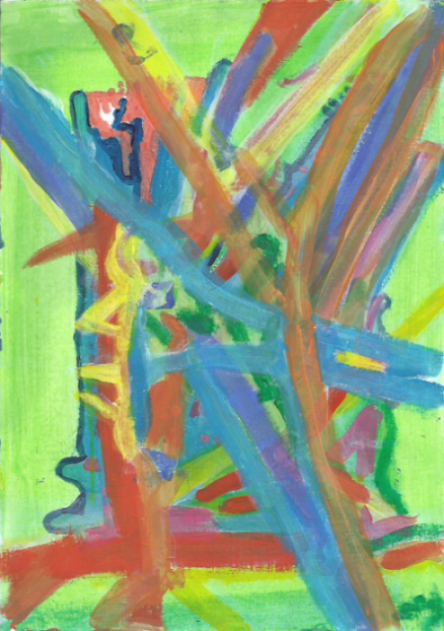
‘Having abandoned wrong livelihood, one continues to make one’s living with right livelihood.’
This is the fifth factor of the noble eightfold path. It is about how we make an income or get food and shelter in this world. Our career.
In the context of the noble eightfold path we aspire towards a livelihood that causes as little harm as possible to ourselves and other beings.
Becoming a Buddhist monk or nun is one way to practise right livelihood. Remembering that the Buddha left the household life, turned his back on being a wealthy prince, shaved his head and beard and went forth into homelessness, begging, wearing rags for robes. He was dependent on the generosity of others to get his food. This way of living goes against the grain of the world, but the spiritual life is unworldly. And showing generosity to one who is on the spiritual path or at any stage of enlightenment creates good kamma (beneficial consequences) for the giver. Which will return to bless them both in this present life and future ones.
But there is nothing wrong with being a lay follower either, the monk’s life is not for everyone, and one can still reach advanced stages of enlightenment as a householder.
When it comes to work and how we conduct our business in the world. We must try to cause as little harm as possible to other beings, and to ourselves. So careers that deal in weapons, poisons, violence, deceit, stealing, polluting, killing, misinformation, exploiting other beings and harming them, are bad career choices.
Always remember as well that you are a being and you matter too, just as much as any other being does. So one should be kind to oneself, and take care not to strain the mind by working long hours. One should not be taken advantage of by an employer, one does not have to be treated like a factory farmed human. One is not a slave to money, to the economy, to a nation, or to any being.
Our time is valuable and we should spend it wisely. We should be calm, dignified, and composed in our dealings with the world whether we are rich or poor, and not allow ourselves to be mistreated by anyone; and in turn we should not mistreat other beings.
In our world of work we should show kindness and friendship to others, but that does not make us a door mat, we assert our boundaries, in a non-hostile way, coming from a place of peace and friendliness. One does not cut short on morals or the spiritual life to please a boss or work colleagues.
We should make time for the other aspects of our life, especially when it comes to the practise of meditation and the development of the spiritual path. There will at times be the need for solitude, to seclude oneself from the world and the energies of others, to retreat and focus on one’s own emotional and spiritual development, which should be prioritised above all else. Above our career. A career is transient and will one day end, but our spiritual development remains and carries over into old age and our next existence.
Right livelihood can also be thought of as right lifestyle. As some people may be retired and out of work for different reasons. In this instance, one should make good use of the time one has and focus on one’s inner development and spiritual progress. Aspiring to live a peaceful lifestyle that causes as little harm as possible to oneself and other beings.
To accomplish this it helps to reflect on the reality of death frequently, to practise the remembrance of it as often as possible. Because death helps energise and motivate us to practise the noble eightfold path and the spiritual life. It reminds us of what is important. Death is universal and comes for all beings, even enlightened ones, and it can come at any moment. We don’t know when it will pay us a visit. Beings in this world die both young and old, across all species of life, and it is normal. The body is fated to one day become a decomposing corpse, (or ashes if cremated,) and the Earth will reclaim it. The body does not belong to us, it is on loan, and will be returned to the elements one day. We borrow these bodies for a brief time, so we should use them wisely.
It is good to remember this, not out of morbidity or in a depressed way. Not out of fear. But in a calm lucid serene way. Making peace with the fact.
Losing attachment to the body now is like making a wise chess move in anticipation of the future. Because whether any of us likes it or not the body does change, it ages, gets sick, loses strength and abilities, gets weak, and eventually dies. Even if you are the most beautiful and talented being in the world, that beauty will not last, that talent will fade, abilities become disabilities. You have no control over any of it. The body came into being and grows and ages all by itself, and so do other people’s bodies.
By losing attachment to the body now, you save yourself a whole bunch of suffering in the future when the inevitable happens. It also saves you a whole bunch of suffering now, because much of our world is caught up in the body. What it looks like, how strong and healthy it is, how smart it is. It causes us so much anxiety, lust, misery, delusion and mental illness. To no longer be caught up in all that is a relief to the mind.
It doesn’t mean one doesn’t take care of the body though. One looks after the body, feels compassion for it and sees to its needs as well as one can. One tries to keep it alive as long as possible, it is our vehicle to enlightenment after all. It is through the body we can realise the end of suffering, stress, and craving, and liberate the mind permanently from the defilements of greed, hatred, and delusion. But one does so without clinging to the body, knowing it is transient and fated to die.
Death will separate us from all that we hold dear. All that is beloved and pleasing to us will become otherwise. We cannot take our body, any of our friends, family, or material possessions with us when we die. It is a journey to a far place we must take alone. The only thing we take with us are our acts of generosity, kindness, and clarity. These are the friends that greet us on the other side and help us both in this life and in the next one to come; in whatever world that may be, there are so many different worlds.
Mindfulness of death (Maraṇasati) helps us remember what is important in life, that the clock is ticking and to use our time wisely.
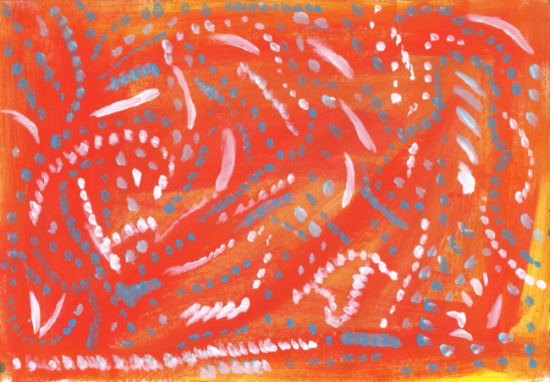
This is the fourth factor of the noble eightfold path, and it is about our behaviour and conduct on this earth. Our morality. Our ethics. How we treat other beings. Morality is an important part of any spiritual practise, without it one will find it difficult to settle into meditation and be at peace.
We want to aspire to pass through this world of myriad beings and cause as little harm as we can. As doing so creates less stress and negative consequences for ourselves and others. It can be summed up quite nicely by the phrase ‘Ahimsa’ which means non-violence.
The three right actions of the noble eightfold path are:
- To refrain from taking the life of any living creature.
- To refrain from taking that which is not given.
- To refrain from sexual misconduct.
All beings value their lives. And all are trying to survive in this world. And most would rather live in peace and friendship with us than be our enemy. No being likes being wronged or hurt, just as much as oneself doesn’t like it.
Watch any insect as you approach and how it runs away afraid. How it tries to hide from you. That being values its life. Imagine how you’d feel if an advanced alien race came and started chasing you, you’d be just like that insect.
The idea that some beings are more important than others is at the root of much of our world’s problems.
Living in peace and friendship with other beings. One’s mind becomes less troubled and averse; more happy; more content. And when the mind is not harrassed by regret, remorse, or fear of retribution. It will find it easier to settle into the deeper states of meditation known as right samhadi (the eighth factor of the noble eightfold path). It is from the lucid stillness of right samhadi that wisdom naturally arises. Because within us all, there is a deeper wiser part of the mind that wants to talk to us, but we often don’t hear it because we are too busy chatting to ourselves about nonsense.
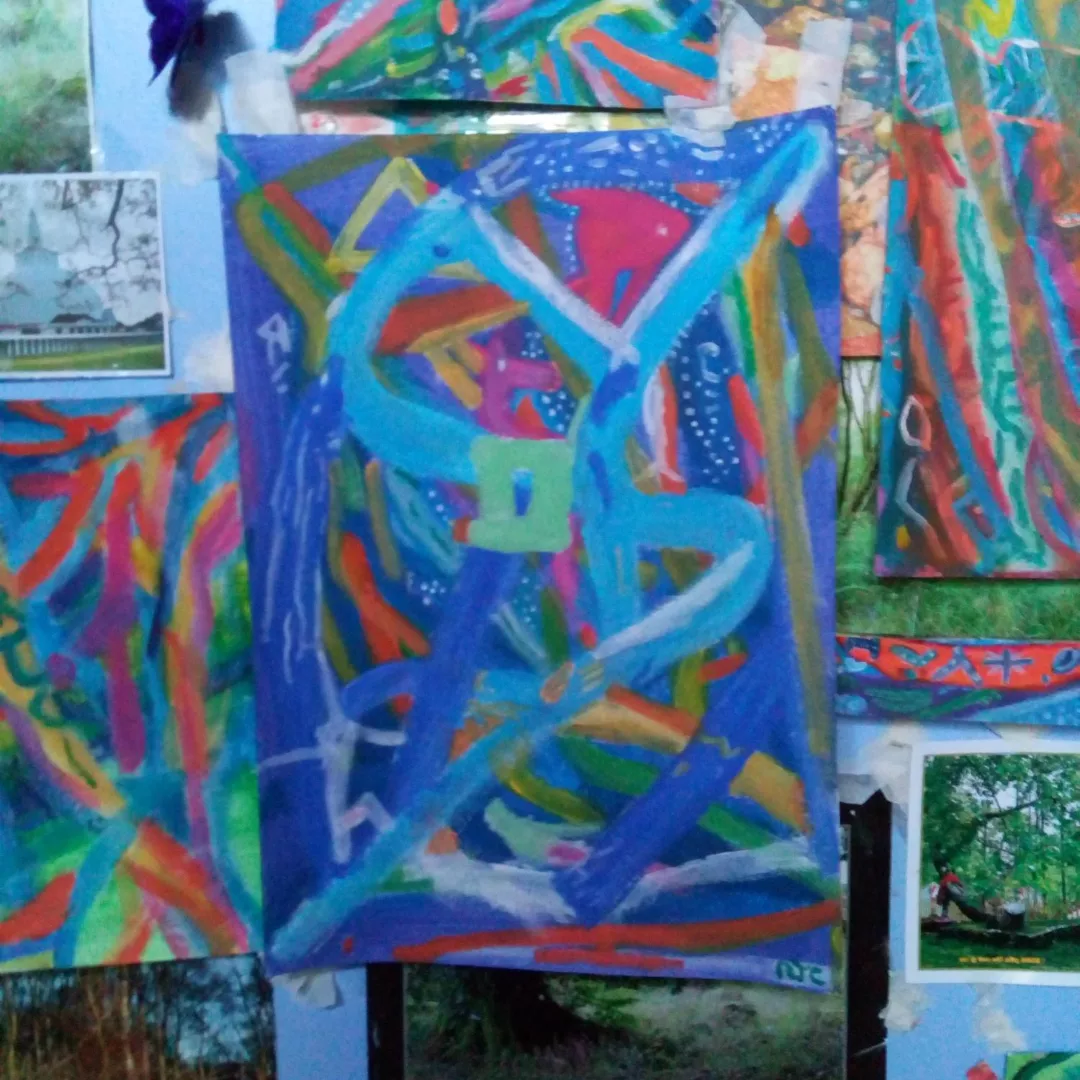
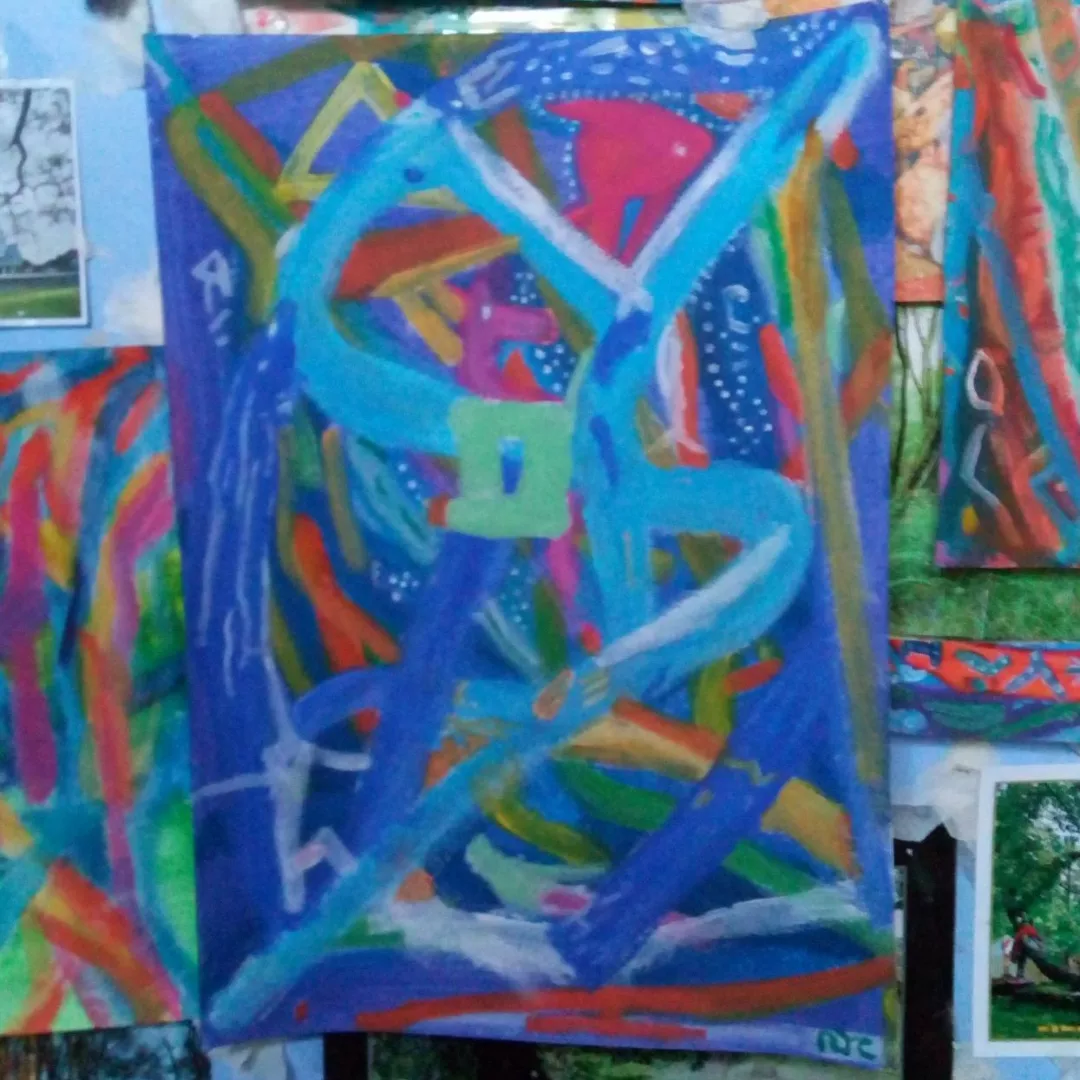
Though these are dark days
I feel something good coming
The wind changing
Re-invigorating hope
Bringing an end to greed, hate, and delusion
Emancipation from ignorance and confusion.
Though the heat is on
And the planet burns
We will sing our song.
Skint and emaciated
Struggling to make ends meet
As the waters come flooding
And the suffering comes spinning
We will go on singing.
A song of genorosity, kindness, and clear-seeing.
About the path of peace that leads to the end of suffering.
About profound friendship and harmony with all beings.
We will go on singing.
Till the day is done
Till extinction's won
And all things fade away
Become undone
Transient
Like a Bubble in a stream
A dream within a dream.
Where is the self?
Insubstantial
Gone.
There is longing
Craving
A desire for something
That creates
Attraction or aversion
Draws and sustains attention.
And with the contact of the senses
and their myriad sense impressions
Feelings arise…
But with well-instructed mindfulness acting as the sentinel of consciousness.
Supported by lucid serenity and unification of mind.
With wisdom as chief.
One nips it in the bud right there.
Prunes away unwholesome states of mind
Before they become the self-centred story of greed, hate and delusion.
With perfected practise
and complete mastery of the mind
With equipose
and dignity.
Liberated to the core
With no more clinging remaining.
One abides in the deathless state
Nibbāna
Unperturbed by the changing phenomena of the world.
Knowing and understanding that all things are anicca (impermanent)
Always changing
rising
flowing
fading.
One remains serene and is not suprised by anything.
This blog might contain posts that are only visible to logged-in users, or where only logged-in users can comment. If you have an account on the system, please log in for full access.
